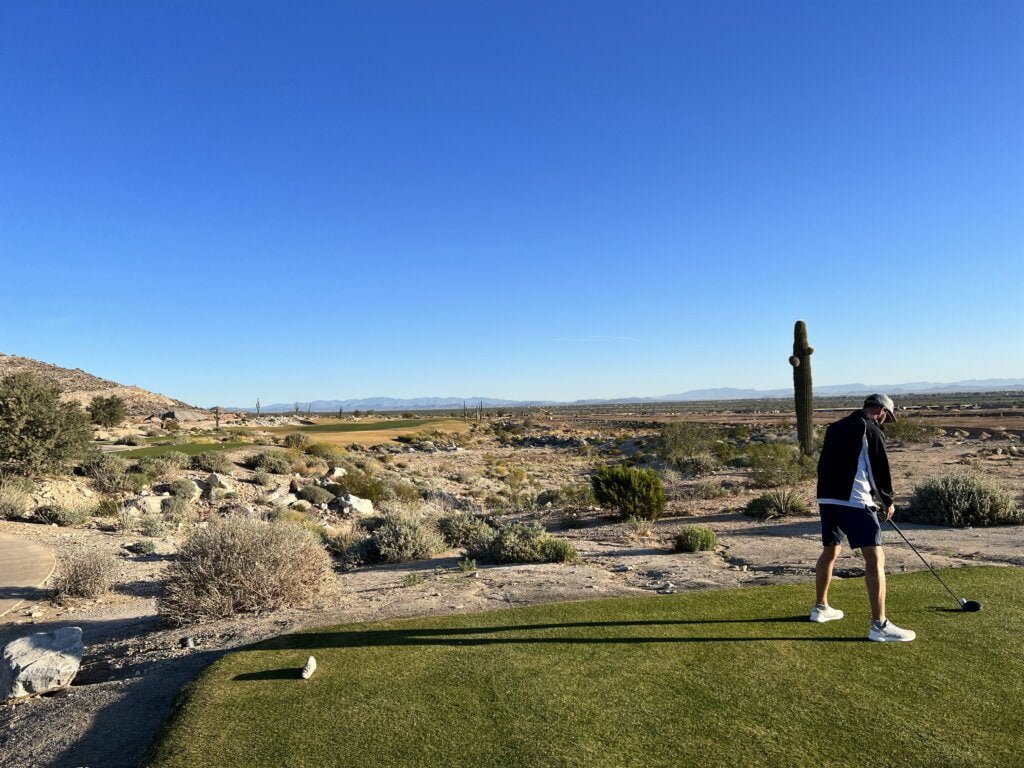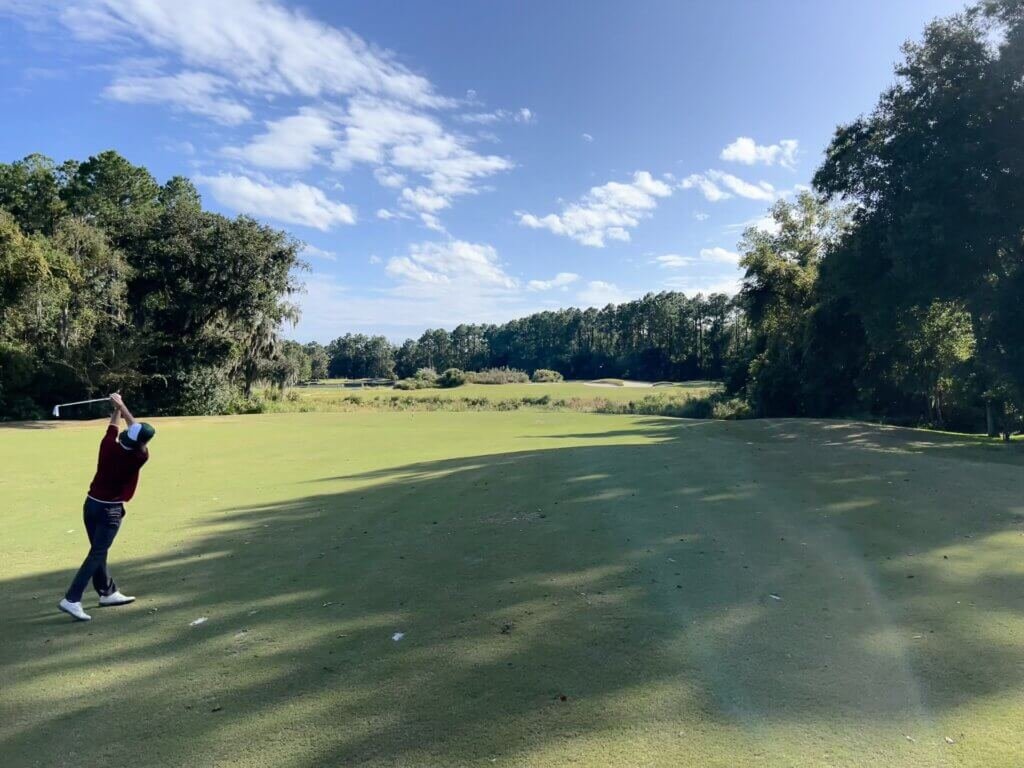
This page uses affiliate links. When you click an affiliate link, we get a small compensation at no cost to you. See Our Affiliate Policy for more info.
For every golf player, whether you are paying to play or playing for free on any landscape, one thing we all can agree on is that there are lots of golf courses out there. If you do not know, the different types of golf courses come in many different shapes and sizes and even different types of golf grasses. Regardless of your golf playing or your putting style, there’ll always be different variants for you to play. The good news is that there are some great golf courses out there, and in this article, we’ll be sharing with you the common courses to try out.
There are three ways to categorize golf courses. First, they can be categorized by access, size, and design. We’ve highlighted the different golf courses based on sizes, design, and access in this piece. Learn more golf terms for beginners here.
When thinking about the different types of golf courses, you must know there are three main design types. These golf courses include:
The golf course in this category include:
The golf course in this category include:
A quick history lesson on the different types of golf courses– golf courses originated in the Scottish region, and the links golf course has its roots in that region. Interestingly, most golf-playing purists believe true link golf courses originated from their region. These courses are built on small sections of sandy areas between farmland and coasts. These courses work perfectly with natural landscapes of strips present on the Scottish and Irish coasts.
To get the full picture of what Links’ golf courses are like, try watching a British Open Championship tournament. This particular championship uses a links-style golf course. Link golf courses provide golf players with a unique experience thanks to land-based physical features that include bunkers, no trees, and different slopes. In addition, you’ll find the style of play on these golf courses appealing, especially if you’re a traditionalist.
The links golf courses are some of the oldest courses in the world. So remember, it is vital to keep link-style courses in excellent condition at all times. Meanwhile, If you wish to play on this course, I hope your green reading skills are top-notch because you’ll need them for the obstruction large greens will inevitably cause.
But note wind plays a huge factor to consider when you choose to play on this golf course, no thanks to the lack of trees coupled with waterfront locations.
First on our list of the different types of golf courses is the parkland-type golf course. Of course, it isn’t built near the ocean. Rather, it is built in the forest. Typically, golf courses that most golfers in the Northern part of America are used to playing. Some of the physical features you’ll notice include trees in the fairways and greens in the heart of sand traps.
But note, you may find different water bodies, but it isn’t as hazardous as what you have with the ocean golf courses. If you are a newbie, the Parkland golf course should be on the top of the list of golf courses to train on, as it makes up the majority of golf courses used around the world. The fairways are flat compared to the type you’ll see on links.
On a side note, if you can’t keep the balls from hitting the trees, then you’ll struggle to play at a parkland golf course. Many people say that this golf course type gets its “Parkland” name from the idea that it playing on it feels like walking in a park. One of the world’s famous Parkland is the Augusta National, a golf course in Augusta, Georgia, in the United States. Interestingly, golf fans can see this golf course type at every Masters tournament.
So, the best easiest way to understand the heathland golf course is to recognize what the word “heath” means. It (Heath) is a section of uncultivated land, especially in Britain, with characteristic vegetation of coarse grasses, gorse, and heather.
Most heathland courses are found in Britain. These inland courses are more open than other courses, such as the Parkland golf course, as their design is based on link courses. The heathland course has many gorses coupled with heather as part of the play. It looks less manicured, unlike Parkland golf courses which usually look manicured. And while most of these heathland golf courses have trees (especially pine trees), many have had these trees on for many years.
These golf courses exist today thanks to people looking for alternative golf courses; surfaces other than the link course. When you juxtapose both heathland and links, you’ll notice that there exist few differences.
Many golf ball-restricted areas on this course aren’t as clearly laid as you’d see on most other golf courses. With a heathland golf course, you may have difficulty finding the spot to target when hitting the ball. Meanwhile, hitting the ball in the fairway is the best option, though once it leaves that surface, there’s no telling what conditions you may be in at the end. And since heathland golf courses are different, the manicure process isn’t manicured the same way.
Australia is the home to some of the most beautiful well-known sandbelt courses, though they often get lost due to their complex location. For instance, the Sandbelt region is home to some of Australia’s finest sandbelt courses, and it’s situated just outside of Melbourne. The soil in this area is, just as you might have guessed, sandy and is also ideal for a game of golf.
Australians have known golf fanatics, and during a golf tournament, the golf courses are usually packed with amazing golf players. Generally speaking, the turf and the playable areas are sandier than the surrounding surfaces. Thus, you’ll experience a softer feel coupled with some awesome edges. And if you’re lucky enough to play on such surfaces, you’re bound to learn a different type of golf. Meanwhile, Sandbelt golf courses aren’t comparable to parkland or links-style golf courses, which is why it has earned its category.
With the way sandbelt golf courses work and how enjoyable they are, it’s quite difficult to find a sandbelt golf course that isn’t great, especially in Australia.


Just as the name suggests, this golf course is what you would expect. It is one of the top tiers of the different types of golf courses. They are typically in hot climates. Also, one notable physical feature you’ll come across in these types of courses is the cactus plant. What makes the desert golf course unique is its contrast feel. The sandy surface, the light, and the contrast of the green grass it provides you with. Viewing the fairways and how green they get when the other areas around them are dry is a beautiful thing.
Desert courses remain an oasis of green amidst the ever-dry landscapes. Yet, while these golf courses complement the natural dunes, the bounding green grasses feel unnatural.
Desert-style golf courses are fairly dry and are on a flat piece of land; players will get a different roll in the fairways while playing. Also, we recommend learning to control the golf ball (being able to hit a draw or a fade) before switching to a desert course.
If you are used to playing lush green golf courses found in the woods, these desert courses will change how you feel about the golf game. We believe these amazing experiences are worth getting. If you are in the U.S.A., you can try out these courses in Nevada and at the WM Phoenix Open in Arizona. Desert golf courses are only situated in hot and dry parts of the world.
The semi-private course has a section designated for its exclusive members, while the other half is meant for public use. Many of the best outer banks golf courses are semi-private. Surprisingly, though this may be confusing, it works well for some golf courses. Semi-private golf courses will restrict public use during the day, giving members the chance to play. However, when few members use the courses on certain afternoons, outsiders will open it. In addition, these types of golf courses offer their members a reduced rate for joining.
An offshoot of this type of golf course is the resort course. The resort owns the course to which the guests present to gain access; meanwhile, non-guests will have to pay in other to make use of the course. Sometimes, the resort or hotel closes the club on weekends to outsiders, and other times, it’s just in the afternoon.
You’ll have to buy the membership package to enjoy the golfing perks in simple terms. You might also receive discounted green fees and preferential tee times.
Both golf clubs and country clubs own and manage private golf courses, and they allow members to play on them after paying an initiation fee. This type of golf course is more expensive. As a golfer, you’ll have to pay annually to keep the privilege of constantly playing on their golf courses. But the catch is; that the money you pay is non-negotiable whether you use the golf club or not.
These golf clubs have other amenities in addition to golf. Typically, you’ll have access to other amenities, including tennis pools, and of course, you’ll gain access to the private course. However, you may not have private clubs in your area, depending on where you live.
Meanwhile, some of the best private golf clubs have waiting lists that you’ll have to get on to gain access to the golf club. On the flip side, they don’t offer as many amenities as a private club.


The other side of the spectrum is the public course. It’s meant for public use. You can try your newly learned skills on a public course if you’re a golf player. These courses are owned by the local government or the town where they are situated. The great thing about this course is that there are discounts for pretty much everyone. You may also find yourself getting some fairly priced golfing sections.
These golf courses aren’t difficult to find, though the only issue you’ll see is that the golf course conditions aren’t as good as most other courses. Some municipal courses have limited budgets, making it difficult to find one that will make you feel like playing in great conditions.
Municipal courses should be enough if you have the perfect level of passion mixed with enough playing budget. So if you wish to play plenty of golf this year, you should always keep that in mind. This is one of the different types of golf courses that accommodates everyone.

Though not a regulation golf course, executive golf courses are longer than three golf courses. You’ll find that you’ve got a few par 4s at an executive style course. It is usually mixed in with some of the other par 3s. Meanwhile, the total par tends to be around 60.
No set number for par makes a golf course an executive one, which means you’ll see a bit of variation here. You might feel overwhelmed by the thoughts of hitting low scores; that’s what these courses do to you. But when you juxtapose the feeling with the fact that the par is ten or more shots less, the overall score may not feel good. As a result, the experience isn’t always positive.
Executive courses are perfect platforms for practicing your short game. And since the full distance is optional, you’ll be able to mainly on chipping and putting.
Learning to hit the bull’s eyes on executive golf courses will, in the end, transform you into a more improved and consistent player. The quality then spills over to a regulation golf course. Great players know that executive golf courses are not just for passing the time but also ideal places to work on your game.
Safe to say, it is designed for quick play. It also focuses mainly on holes that can be made within a relatively short time frame. It is also perfect for golfers coming back from work who need to relax and chill with fellow executives after a long day. Executive golf course often has 9 or 18 holes. 18-hole executive golf courses are no higher than par 65.
This is a typical course of standard length. Most of these golf courses are around six thousand to eight thousand yards. They’ll also offer several tees for golf players of different handicap levels. Regulation fold courses have a par ranging from 70 to 72. It includes a combination of several par 3s, par 4s, and par 5s.
If you play regulation golf courses, you’ll find yourself opting between nine or eighteen holes each time you go out to play. When you talk about golf course types by size, the regulation golf course will readily come to mind—18-hole golf courses, executive courses, and par three golf courses.


These two often go together. Both golf courses are designed to host different golf tournaments – big or small. When a golf club says they have a “championship course,” it only means 18 holes and nothing else. It is typically a course like TPC Scottsdale or TPC Sawgrass. It is fairly tough and long. Meanwhile, the phrase “championship” distinguishes golf courses if (and when) a club has multiple options to pick from. However, you could also define championship courses as hosting big tournaments. It often cuts down the list drastically.
A Stadium course might also have a more defined meaning. Stadium courses consist of TPC courses, as they were designed with spectators in mind to provide easy movement for spectators. Some common features include amazing holes and vantage points for spectators to view fully.
The approach golf course is shorter than a par-3 course. It is designed to allow golfers to practice golf pitching and golf chipping. The holes found on approach courses often include around 90 to 100 yards in length, though most can be shorter. Some can even be as short as 40 yards. Once you’ve dropped the ball, pitch it to the green; next, putt it out.
There are lots of golf courses, so much so that you could get bored trying out all of them. But it won’t hurt if you do anyways.